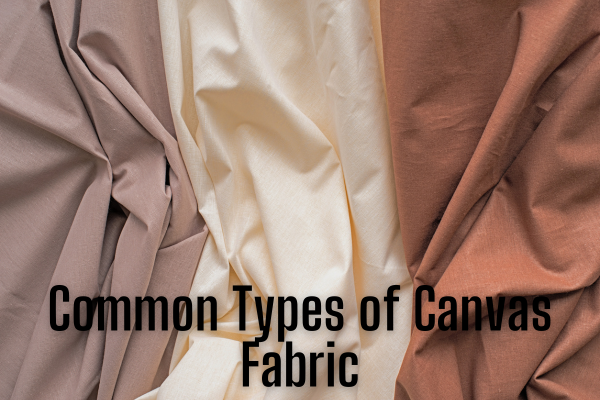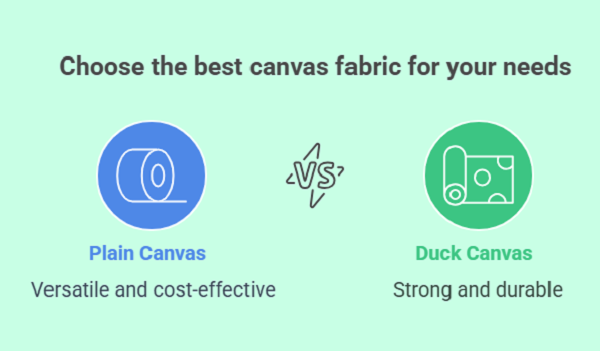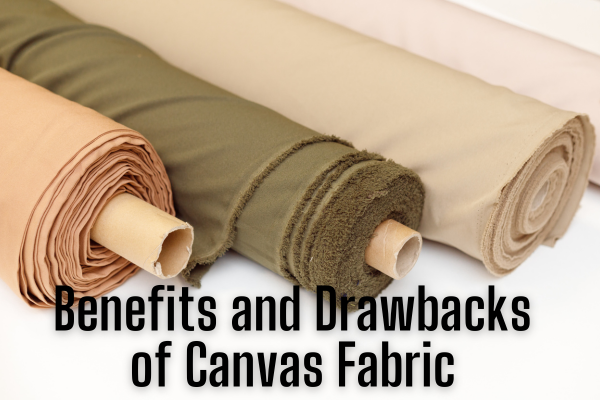Ever sat on a sturdy camping chair or carried a rugged tote that just wouldn’t quit? That’s probably canvas fabric doing its thing — quietly flexing its muscles behind the scenes. It’s one of those no-nonsense textiles. Not flashy. Just built different.
Table of Contents
What is Canvas Fabric?

A Quick History Lesson
Canvas fabric has been around for centuries. We’re talking sails on Viking ships and da Vinci painting the Mona Lisa on it. Historically made from hemp, it later transitioned to cotton and, in modern blends, includes polyester.
It’s thick. It’s tough. And it’s everywhere.
Basic Composition and Weave
Canvas fabric is woven using a plain weave — the simplest and tightest of them all. That’s why it’s so dense. Usually made from 100% cotton or a cotton-poly blend, it typically ranges from 7 oz to 24 oz per square yard. For context, your average T-shirt? That’s around 4 oz. Canvas laughs in the face of fragility.
Common Types of Canvas Fabric

Plain Canvas
This is the basic, everyday canvas. Good for crafts, painting, or casual bags. It’s affordable and easy to dye.
Duck Canvas
“Duck” comes from the Dutch word “doek,” meaning cloth. It’s smoother and tighter than plain canvas. If you’re buying a work jacket or a tool belt — chances are, it’s duck.

Waxed Canvas
Imagine canvas but tougher, with a water-repelling finish. That’s waxed canvas. Popular in backpacks, bike bags, and jackets. It develops a beautiful patina over time, kind of like aged leather.
Key Characteristics of Canvas Fabric
Durability by the Numbers
Canvas fabric boasts impressive tensile strength — up to 3,000 psi depending on the weave and blend. For comparison, denim rarely exceeds 1,500 psi. That’s double the muscle.
Water Resistance and Breathability
Canvas is naturally breathable, but not waterproof unless treated. Waxing, PU coating, or PVC backing improves its weather defense. The water resistance can hit up to 1,000 mm in hydrostatic head tests — enough to keep your gear dry during light rain.
Canvas Weight (GSM & Oz): What You Should Know
- 7 oz = ~237 GSM — Light and pliable
- 10 oz = ~340 GSM — Midweight
- 12–24 oz = ~400–800 GSM — Heavy-duty
Luggage-grade canvas? You’re usually looking at 18 oz and above.
Where is Canvas Fabric Used?
Canvas in Fashion
Tote bags, sneakers, and jackets — canvas does casual cool with ease. Brands like Converse and Carhartt rely heavily on it. And hey, those canvas sneakers you’ve owned for 4 years? Still kicking.
Heavy-Duty Industrial Use
Think tents, tarps, and tool bags. Canvas fabric stands tall where other fabrics crumble. Some industrial canvases are even fire-retardant, meeting NFPA 701 standards.
Home Decor and Art Applications
Artists swear by canvas for oil and acrylic painting. Upholstery, curtains, and even cushion covers — canvas works like a charm indoors too. It offers a rustic, handcrafted feel that other fabrics just don’t.
Benefits and Drawbacks of Canvas Fabric

Advantages That Make Canvas Shine
- Insane durability — Built to last decades.
- Eco-friendly — Especially the cotton or hemp ones.
- Customizable — Easy to dye, print, and coat.
- Versatile — Fashion to construction, art to aviation.
Limitations You Shouldn’t Ignore
- Stiff initially — Needs break-in time.
- Can be heavy — Not ideal for light, floaty garments.
- Prone to mildew — If stored damp.
- Not stretchable — Zero give unless blended with spandex.
How to Care for Canvas Fabric
Cleaning Tips
Mild soap. Cold water. No harsh detergents. Machine wash only if it’s pre-shrunk — otherwise, hand wash is your best bet.
Avoid bleach. Always air dry. Tumble drying? Risky business.
Storage and Long-Term Maintenance
Keep it dry. Roll instead of folding to avoid creases. For waxed canvas, re-wax it once or twice a year depending on usage.
Canvas Fabric vs Other Heavyweight Fabrics
Denim vs Canvas
Denim uses a twill weave — it’s softer but less dense. Canvas is better for structure and load-bearing items. Denim fades—canvas ages.
Oxford vs Canvas
Oxford fabric is more refined — ideal for dress shirts or linings. Canvas? Built for war. Oxford can fray. Canvas holds its edge.
Polyester Blends vs Canvas
Poly blends offer more stretch and less weight. But canvas wins in abrasion resistance and breathability, especially if it’s cotton-based.
Conclusion
Canvas fabric isn’t fancy. It doesn’t need to be. It’s the quiet workhorse of the textile world. Strong, reliable, and just versatile enough to surprise you. Whether you’re painting a masterpiece or hauling tools through the rain, canvas fabric has your back.
FAQs
1. Is canvas fabric waterproof?
Not by default. But waxed or PVC-coated canvas can repel water very effectively.
2. How long does canvas fabric last?
With proper care, canvas products can last 10–20 years or even longer.
3. Can canvas fabric be used for clothing?
Yes, especially for jackets, aprons, and workwear. It’s tough and protective.
4. Is canvas breathable?
Cotton canvas is breathable. Coated canvas (like PVC) sacrifices breathability for water resistance.
5. How eco-friendly is canvas fabric?
If made from natural fibers like cotton or hemp and dyed sustainably, canvas is among the more eco-friendly textiles out there.
